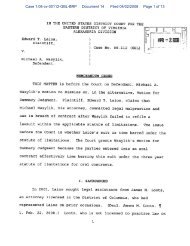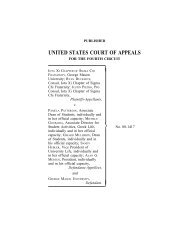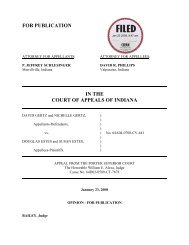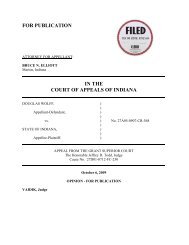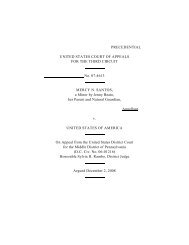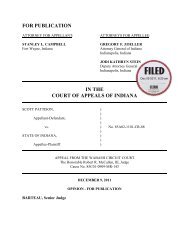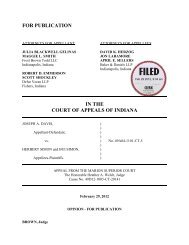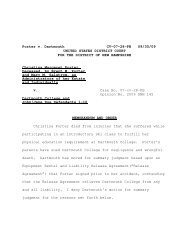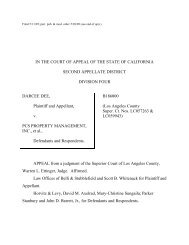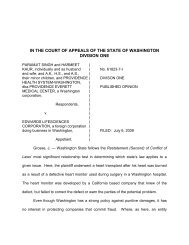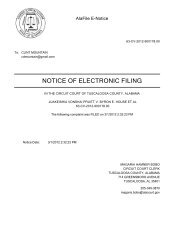1 CERTIFIED FOR PUBLICATION IN THE COURT OF ... - FindLaw
1 CERTIFIED FOR PUBLICATION IN THE COURT OF ... - FindLaw
1 CERTIFIED FOR PUBLICATION IN THE COURT OF ... - FindLaw
Create successful ePaper yourself
Turn your PDF publications into a flip-book with our unique Google optimized e-Paper software.
Filed 2/16/11<br />
<strong>CERTIFIED</strong> <strong>FOR</strong> <strong>PUBLICATION</strong><br />
<strong>IN</strong> <strong>THE</strong> <strong>COURT</strong> <strong>OF</strong> APPEAL <strong>OF</strong> <strong>THE</strong> STATE <strong>OF</strong> CALI<strong>FOR</strong>NIA<br />
JERID ROSENCRANS et al.,<br />
v.<br />
Plaintiffs and Appellants,<br />
DOVER IMAGES, LTD.,<br />
Defendant and Respondent.<br />
FOURTH APPELLATE DISTRICT<br />
DIVISION TWO<br />
1<br />
E049899<br />
(Super.Ct.No. RIC498185)<br />
OP<strong>IN</strong>ION<br />
APPEAL from the Superior Court of Riverside County. Mac R. Fisher, Judge.<br />
Affirmed in part; reversed in part.<br />
Perona, Langer, Beck, Serbin & Mendoza, Ronald Beck and Ellen R. Serbin for<br />
Plaintiffs and Appellants.<br />
Gilbert, Kelly, Crowley & Jennett, Peter J. Godfrey and Timothy W. Kenna for<br />
Defendant and Respondent.<br />
Plaintiffs and appellants Jerid and Amy Rosencrans (plaintiffs) sued defendant<br />
and respondent Dover Images, Ltd. (Dover) for (1) negligence; (2) negligent training<br />
and supervision; and (3) loss of consortium. The trial court granted Dover‟s motion for
summary judgment as to all of the causes of action. Plaintiffs contend that the trial<br />
court erred by granting summary judgment because they presented triable issues of fact.<br />
We affirm in part, and reverse in part.<br />
A. FACTS<br />
FACTUAL AND PROCEDURAL HISTORY<br />
Dover does business as Starwest Motocross, and operates a motocross track<br />
known as Starwest Motocross Track (the track). The track is located at the Lake Perris<br />
Fairgrounds in Perris. On June 17, 2007, at the time of the incident in this case, the<br />
track‟s length was 0.6 of a mile. Before entering the track facility, patrons were<br />
required to stop their cars at a booth that was staffed by a Starwest employee. At the<br />
booth, while the patron was in his or her car, the patron paid a fee and signed a release<br />
and waiver of liability.<br />
Jerid Rosencrans (Jerid) 1 had been riding motorcycles since he was 14 years old;<br />
on June 17, 2007, Jerid was 38 years old. On June 17, 2007, at 7:00 or 7:30 p.m., Jerid<br />
arrived at the track. He was driving his truck, with his motorcycle in the truck‟s bed.<br />
Jerid stopped his truck at the entrance booth at the Starwest facility. The Starwest<br />
employee in the booth gave Jerid a clipboard with the release document and said,<br />
“„Here, just sign in,‟” or “„Here, sign this.‟”<br />
1 For the sake of clarity and intending no disrespect, we refer to Jerid<br />
Rosencrans by his first name. (See In re Estate of Hastie (2010) 186 Cal.App.4th 1285,<br />
1290, fn. 2.)<br />
2
The document was titled, “Release and Waiver of Liability Assumption of Risk<br />
and Indemnity Agreement,” (the Release) and underneath the title were approximately<br />
nine paragraphs. The paragraphs set forth the waiver and release. For example, one of<br />
the paragraphs read: “2. Hereby releases, waives, discharges and covenants not to sue<br />
the owner of the Premises, any individual engaging in the Activities, rescue personnel,<br />
and the Premises inspectors, surveyors, underwriters, consultants and others who give<br />
recommendations, directions or instructions or engage in risk evaluation or loss control<br />
activities regarding the Premises, and each of them, their directors, officers, agents and<br />
employees[,] from all liability to the Undersigned for any and all loss or damage and<br />
any claim or demands therefore on account of injury to the person or property or<br />
resulting in death of the Undersigned arising out of or related to the use of the Premises<br />
for the Activities, whether caused by the negligence of the Releasees or otherwise.”<br />
Underneath the paragraphs were multiple horizontal lines, separated into four<br />
columns, where patrons can print and sign their names. In the section where patrons<br />
signed their names, they were required to sign their name over the words “I have read<br />
this release.” The following illustrates the signature portion of the document:<br />
Print Name Here Sign Name Here Witness Date<br />
_____________ I HAVE READ THIS RELEASE _______ ____<br />
_____________ I HAVE READ THIS RELEASE _______ ____<br />
_____________ I HAVE READ THIS RELEASE _______ ____<br />
On the Release, Jerid printed his name, and signed his name over the words “I<br />
HAVE READ THIS RELEASE.” Jerid signed the Release within approximately 10<br />
3
seconds of the document being handed to him. Jerid was not given a copy of the<br />
Release that he signed. The total exchange at the entrance booth lasted approximately<br />
30 seconds.<br />
Approximately 20 other motocross riders were practicing on the track when Jerid<br />
arrived—there was not a race occurring at the track. Jerid put on his goggles, helmet,<br />
and chest protector, and proceeded to ride his motorcycle on the track. Jerid had been<br />
riding on the track for approximately 30 minutes when he went up a ramp for a jump<br />
and fell, landing on the downslope of the ramp, which placed him outside of the view of<br />
the other riders. Jerid was not hurt, and proceeded to stand and pick up his motorcycle.<br />
Approximately 30 seconds later, a motorcyclist on the track struck Jerid.<br />
Approximately 20 seconds after that collision, a second motorcyclist struck Jerid.<br />
Jerid‟s complaint alleges that the collisions caused him to suffer “serious and severe<br />
injuries.” 2<br />
Jerid‟s initial fall took place near a platform where a person employed as a<br />
“caution flagger” would typically stand. From the platform, a “caution flagger” can see<br />
riders who have fallen down, and then alert other riders, who are unable to see fallen<br />
motorcyclists, that there is a fallen motorcyclist on the track. There was at least one<br />
caution flagger at the track when Jerid fell; however, at the time of the fall, the caution<br />
2 It is not clear exactly what injuries, if any, Jerid sustained. The “Facts” section<br />
of plaintiffs‟ opening brief reflects that Jerid was “injured”; however, it does not reflect<br />
the extent of the injuries or the type of injuries sustained. We have reviewed Jerid‟s<br />
declaration, and the portions of Jerid‟s deposition transcription that are included in the<br />
record; neither document reflects the extent of Jerid‟s injuries nor the type of injuries<br />
sustained.<br />
4
flagger was not on the platform near the location where Jerid fell. Jerid saw a caution<br />
flagger on the far side of the track from where he fell, and he saw the caution flagger<br />
run towards him prior to being struck by the second motorcyclist.<br />
B. PROCEDURAL HISTORY<br />
1. COMPLA<strong>IN</strong>T<br />
Plaintiffs alleged three causes of action against Dover. First, Jerid alleged Dover<br />
“negligently owned, operated, maintained and/or controlled” the track. Second, Jerid<br />
alleged Dover failed to adequately supervise and train its employees. Third, Jerid‟s<br />
wife alleged the foregoing negligent acts caused her to be deprived of Jerid‟s support,<br />
love, care, companionship, and sexual relations.<br />
2. MOTION <strong>FOR</strong> SUMMARY JUDGMENT<br />
Dover moved for summary judgment. In regard to the first and second causes of<br />
action, Dover asserted Jerid‟s claim was barred by Jerid‟s execution of the Release. In<br />
regard to the loss of consortium cause of action, Dover argued the claim was barred<br />
because it was derivative of the barred first and second causes of action.<br />
3. OPPOSITION TO <strong>THE</strong> MOTION <strong>FOR</strong> SUMMARY JUDGMENT<br />
Plaintiffs opposed Dover‟s motion for summary judgment. First, plaintiffs<br />
asserted the Release could be found to be unenforceable because (1) the Dover<br />
employee at the booth represented the document was a sign-in sheet; (2) the Release<br />
was written in a small font; (3) Dover never informed Jerid he was signing a release; (4)<br />
Jerid did not know he was signing a release; (5) the title of the document was obscured<br />
by the clipboard‟s metal clip; (6) Dover did not give Jerid a copy of the Release; and (7)<br />
5
there was insufficient time for Jerid to read the Release while stopped at the entrance<br />
booth. Plaintiffs argued the foregoing evidence showed that Jerid may not have freely<br />
entered into the Release, which would create a triable issue of fact as to whether the<br />
Release was void.<br />
Second, plaintiffs argued that even if the Release were enforceable, it could not<br />
bar a claim for gross negligence. Plaintiffs asserted that they produced evidence<br />
creating a triable issue of fact for gross negligence on the part of Dover. Specifically,<br />
plaintiffs argued (1) Dover had “a duty to have caution flaggers at a permanent station”;<br />
(2) Dover failed to place a caution flagger at the platform near the site of Jerid‟s fall;<br />
and (3) a caution flagger did not warn other motorcyclists that Jerid had fallen on the<br />
track for approximately 30 seconds.<br />
Additionally, plaintiffs argued there was evidence Dover was grossly negligent<br />
in its hiring and supervising of employees. Plaintiffs asserted their expert declared that<br />
Jerid‟s “injuries were caused by caution flaggers who were not properly trained or<br />
supervised.” Plaintiffs argued that since the negligence claims were viable, the loss of<br />
consortium claim was also viable.<br />
4. REPLY TO <strong>THE</strong> OPPOSITION TO <strong>THE</strong> MOTION <strong>FOR</strong><br />
SUMMARY JUDGMENT<br />
Dover replied to plaintiffs‟ opposition to the motion for summary judgment.<br />
First, Dover argued the Release was enforceable. Dover argued that even if the<br />
employee referred to the Release as a “sign-in sheet” then plaintiffs failed to show any<br />
reliance on the misrepresentation; for example, plaintiffs did not show Jerid would not<br />
6
have ridden at the track if he had been aware of the language of the Release.<br />
Additionally, Dover argued plaintiffs failed to provide evidence that Dover‟s conduct<br />
rose to the level of gross negligence. Alternatively, Dover argued plaintiffs‟ claims<br />
were barred by the assumption of the risk doctrine, because Jerid assumed the risk of<br />
being injured by participating in the sport of motocross. Finally, Dover argued<br />
plaintiffs failed to provide proof that Dover‟s employees were inadequately trained and<br />
supervised.<br />
5. RUL<strong>IN</strong>G ON <strong>THE</strong> MOTION <strong>FOR</strong> SUMMARY JUDGMENT<br />
The trial court granted Dover‟s motion for summary judgment. The trial court‟s<br />
decision was separated into four parts. First, the trial court concluded the Release was<br />
enforceable, and therefore the first and second causes of actions were barred by the<br />
Release. Second, the trial court held the undisputed facts showed that Dover‟s conduct<br />
did not rise to the level of gross negligence. Third, the trial court concluded Jerid<br />
assumed the risk of being injured when he participated in the sport of motocross.<br />
Fourth, the trial court held the loss of consortium cause of action was derivative of the<br />
negligence causes of action, and therefore, it too failed as a matter of law.<br />
DISCUSSION<br />
A. EN<strong>FOR</strong>CEABILITY <strong>OF</strong> <strong>THE</strong> RELEASE<br />
In Dover‟s motion for summary judgment, it cited the Release as an affirmative<br />
defense. The trial court found in favor of Dover. Plaintiffs contend they raised a triable<br />
issue of fact regarding whether the Release was void. Plaintiffs assert they produced<br />
evidence showing that Jerid was not aware that he was signing a waiver and release of<br />
7
his rights. Specifically, plaintiffs assert the Release was void due to the legal principle<br />
of “fraud in the execution.” We disagree.<br />
“Fraud in the execution” means that the promisor is deceived as to the nature of<br />
his act, and actually does not know what he is signing, or does not intend to enter into a<br />
contract at all; since mutual assent is lacking, the contract is void. (Duffens v. Valenti<br />
(2008) 161 Cal.App.4th 434, 449.) However, a contract will not be “considered void<br />
due to the fraud if the plaintiff had a reasonable opportunity to discover the true terms of<br />
the contract. The contract is only considered void when the plaintiff‟s failure to<br />
discover the true nature of the document executed was without negligence on the<br />
plaintiff‟s part. [Citation.] [] This issue usually arises when the plaintiff failed to read<br />
the terms of the contract, relying instead on the defendant‟s representation as to the<br />
effect of the contract. Generally, it is not reasonable to fail to read a contract; this is<br />
true even if the plaintiff relied on the defendant‟s assertion that it was not necessary to<br />
read the contract. [Citation.] Reasonable diligence requires a party to read a contract<br />
before signing it. [Citation.]” (Brown v. Wells Fargo Bank, N.A. (2008) 168<br />
Cal.App.4th 938, 958-959.)<br />
Jerid testified that he can read English and that he attended college. The Dover<br />
employee gave Jerid the Release before he entered the Starwest facility, and said,<br />
“„Here, just sign in,‟” or “„Here, sign this.‟” Jerid was in his truck at the time he was<br />
given the Release to sign. There were approximately 10 cars in line behind Jerid. The<br />
foregoing evidence reflects that Jerid was given an opportunity to read the terms of the<br />
agreement. Jerid could have read the Release while in line, or he could have moved his<br />
8
truck to the side and read the Release. There is nothing indicating that Jerid was forced<br />
to sign the Release or that he was somehow denied an opportunity to read the Release<br />
before signing it. Consequently, we conclude that Jerid had a reasonable opportunity to<br />
discover the true terms of the contract. Jerid‟s failure to read the Release was due to his<br />
own negligence, because the evidence indicates that there was nothing preventing him<br />
from reading the Release. In sum, the Release is not void due to fraud in the execution.<br />
Plaintiffs assert that Jerid did not “freely and knowingly” enter into the Release<br />
because (1) the Dover employee represented the Release was a sign-in sheet; (2) the<br />
metal clip of the clipboard obscured the title of the document; (3) the Release was<br />
written in a small font; (4) Dover did not inform Jerid he was releasing his rights by<br />
signing the Release; (5) Jerid did not know he was signing a release; (6) Jerid did not<br />
receive a copy of the Release; and (7) Jerid was not given adequate time to read or<br />
understand the Release.<br />
We do not find plaintiffs‟ argument persuasive because, as set forth ante, there<br />
was nothing preventing Jerid from reading the Release. There is nothing indicating that<br />
Jerid was prevented from (1) reading the Release while he sat at the booth, or (2) taking<br />
the Release, moving his truck out of the line, and reading the Release. In sum,<br />
plaintiffs‟ arguments do not persuade us that Jerid was denied a reasonable opportunity<br />
to discover the true terms of the contract.<br />
B. RELEASE AS AN AFFIRMATIVE DEFENSE<br />
The Release provides that Jerid agreed to waive his right to sue Starwest for any<br />
losses or damages suffered on account of an injury related to using the track, “whether<br />
9
caused by the negligence of [Starwest] or otherwise.” Based upon the plain language of<br />
the Release, we conclude that Jerid waived his right to sue Dover for ordinary<br />
negligence as well as negligent hiring and supervision. 3 (See Griffin Dewatering Corp.<br />
v. Northern Ins. Co. of New York (2009) 176 Cal.App.4th 172, 204 [plain language is an<br />
important principle of contract interpretation].)<br />
C. GROSS NEGLIGENCE<br />
Plaintiffs contend the trial court erred by granting Dover‟s motion for summary<br />
judgment because there are triable issues of fact related to the allegation of gross<br />
negligence. We agree.<br />
1. <strong>THE</strong> RELEASE<br />
We briefly explain why gross negligence is exempt from the Release. California<br />
cases have long held that liability for ordinary negligence may be released; however,<br />
gross negligence has been distinguished—“no published California case has upheld . . .<br />
an agreement purporting to release liability for future gross negligence.” (Santa<br />
Barbara, supra, 41 Cal.4th at pp. 758, 777.) Our Supreme Court has specifically<br />
concluded “that an agreement made in the context of sports or recreational programs or<br />
3 “California courts have invalidated releases of liability for future ordinary<br />
negligence . . . when . . . the court determines that a particular release concerns a service<br />
that transcends a purely private agreement and affects the public interest.” (City of<br />
Santa Barbara v. Superior Court (2007) 41 Cal.4th 747, 757, italics omitted (Santa<br />
Barbara).) Plaintiffs have not argued that the Release is invalid because it released<br />
future liability for ordinary negligence. Typically “courts have upheld releases of<br />
liability concerning ordinary negligence related to . . . auto and motorcycle racing<br />
events . . . .” (Id. at p. 759, fns. omitted.) Consequently, since the issue was not raised,<br />
and law typically holds that the recreational sport releases are valid, we assume that this<br />
issue is not applicable to the Release.<br />
10
services, purporting to release liability for future gross negligence, generally is<br />
unenforceable as a matter of public policy.” (Id. at p. 751.) Thus, while plaintiffs‟<br />
claims for ordinary negligence are barred by the Release, their claim for gross<br />
negligence would not be barred by the Release due to public policy concerns.<br />
2. TRIABLE ISSUE <strong>OF</strong> FACT<br />
Gross negligence is pleaded by alleging the traditional elements of negligence:<br />
duty, breach, causation, and damages. (Jones v. Wells Fargo Bank (2003) 112<br />
Cal.App.4th 1527, 1541.) However, to set forth a claim for “gross negligence” the<br />
plaintiff must allege extreme conduct on the part of the defendant. (Eastburn v.<br />
Regional Fire Protection Authority (2003) 31 Cal.4th 1175, 1185-1186 (Eastburn).)<br />
The conduct alleged must rise to the level of “either a „“„want of even scant care‟”‟ or<br />
„“„an extreme departure from the ordinary standard of conduct.‟”‟ [Citations.]” (Santa<br />
Barbara, supra, 41 Cal.4th at p. 754, fn. omitted.)<br />
a) Duty<br />
Whether a duty exists is a legal question, which is decided by the court, rather<br />
than the trier of fact. (Souza v. Squaw Valley Ski Corp. (2006) 138 Cal.App.4th 262,<br />
266.) As a general rule, people have a duty to use due care to avoid injuring others.<br />
(Knight v. Jewett (1992) 3 Cal.4th 296, 315.) However, dangerous conduct or<br />
conditions are often an integral part of participating in sports (ibid); therefore, when a<br />
plaintiff is injured while participating in a dangerous sport, the duty analysis becomes<br />
intertwined with an exception to the general duty of care rule known as “assumption of<br />
the risk.” The “assumption of the risk” doctrine provides an exception to the general<br />
11
duty of care rule when a plaintiff is injured while voluntarily participating in a risky<br />
activity. (Luna v. Vela (2008) 169 Cal.App.4th 102, 108.) Our Supreme Court has<br />
broken “assumption of the risk” into two categories: (1) primary assumption of the risk,<br />
which affects the duty analysis; and (2) secondary assumption of the risk, which affects<br />
the damages analysis. (Shin v. Ahn (2007) 42 Cal.4th 482, 489.)<br />
Primary assumption of the risk means that the plaintiff has voluntarily<br />
participated in a sport that includes various inherent risks, and therefore, the defendant<br />
is relieved of his or her duty to use due care to avoid the plaintiff suffering an injury as a<br />
result of those inherently risky aspects of the sport. (Knight v. Jewett, supra, 3 Cal.4th<br />
at pp. 308-309, fns. 3-4, 315-316.) The question of whether a defendant should be<br />
relieved of his or her duty is a question of law and policy. (Avila v. Citrus Community<br />
College Dist. (2006) 38 Cal.4th 148, 161.) A court must evaluate (1) the fundamental<br />
nature of the sport, and (2) the defendant‟s relationship to the sport, in order to<br />
determine if the defendant should be relieved of his or her general duty of care. (Ibid.)<br />
As a matter of policy, a duty should not be imposed where doing so “would require that<br />
an integral part of the sport be abandoned, or would discourage vigorous participation in<br />
sporting events.” (Kahn v. East Side Union High School Dist. (2003) 31 Cal.4th 990,<br />
1004.) If the defendant is relieved of his or her duty of care, then the plaintiff‟s<br />
negligence cause of action is barred. (Cheong v. Antablin (1997) 16 Cal.4th 1063,<br />
1068.)<br />
Secondary assumption of the risk affects the damages analysis, rather than the<br />
duty analysis. (Shin v. Ahn, supra, 42 Cal.4th at p. 498.) In secondary assumption of<br />
12
the risk, the defendant owes the plaintiff a duty, but the plaintiff shares the fault for his<br />
or her injury, and therefore, the damages must be apportioned between the parties.<br />
(Parsons v. Crown Disposal Co. (1997) 15 Cal.4th 456, 480.) We begin our analysis<br />
with primary assumption of the risk.<br />
(1) Fundamental Nature of the Sport<br />
In the present case, we must determine whether being crashed into twice by<br />
coparticipants is a risk inherent in the sport of motocross. (See Staten v. Superior Court<br />
(1996) 45 Cal.App.4th 1628, 1633 [Framing the issue as determining “whether being<br />
cut by the blade of a fellow skater during a group skating session is, as a matter of law,<br />
a risk inherent in the sport of figure skating.”].)<br />
“„“[I]t is thoroughly established that experts may not give opinions on matters<br />
which are essentially within the province of the court to decide.” [Citation.]‟<br />
[Citation.]” (Staten v. Superior Court, supra, 45 Cal.App.4th at p. 1635.) Accordingly,<br />
the legal question of duty, and specifically the question of whether a particular risk is an<br />
inherent part of a sport, “is necessarily reached from the common knowledge of judges,<br />
and not the opinions of experts.” (Ibid.)<br />
Motocross is a sport in which people ride motorcycles and perform jumps off of<br />
ramps, while in a setting filled with dust and other people on motorcycles. Given the<br />
racetrack setting, speed involved, and jumping maneuvers, it follows that coparticipants<br />
will fall down, and while down, be struck by other riders whose views are obscured by<br />
the blind corners, blind ramps, dust, and/or other riders. (See Branco v. Kearny Moto<br />
Park, Inc. (1995) 37 Cal.App.4th 184, 193 [jumps and falls are inherent risks in BMX<br />
13
(bicycle) competitions]; see also Distefano v. Forester (2001) 85 Cal.App.4th 1249,<br />
1264 (Distefano) [collisions with coparticipants are an inherent risk in the sport of off-<br />
roading (dune buggies and motorcycles)].)<br />
(2) Status of Defendant<br />
We now examine defendant‟s relationship to the sport. An owner/operator of a<br />
sports facility has a duty to provide a reasonably safe course or track. (Morgan v. Fuji<br />
Country USA, Inc. (1995) 34 Cal.App.4th 127, 134.) This duty requires an owner or<br />
operator to “„to minimize the risks without altering the nature of the sport. [Citations.]‟<br />
[Citation.]” (Ibid.; see also Kahn v. East Side Union High School Dist., supra, 31<br />
Cal.4th at p. 1004 [“minimize the risk without altering the nature of the sport”]; see also<br />
Knight v. Jewett, supra, 3 Cal.4th at p. 317 [“minimize the risks without altering the<br />
nature of the sport”].)<br />
In the sport of motocross, an owner/operator of a track has a duty to minimize the<br />
risk of a coparticipant crashing into a second coparticipant who has fallen on the track.<br />
Providing a warning system of some sort, such as caution flaggers to alert riders of a<br />
fallen participant, would assist in minimizing the risk of riders colliding with one<br />
another. If a rider received adequate warning of a fallen rider on the track, then the<br />
rider could change his or her course to avoid the fallen rider. Further, providing a<br />
warning system, such as caution flaggers, would not alter the sport, because it would not<br />
prevent riders from jumping and traveling at high speeds, rather it would provide the<br />
riders with information so that they could alter their course as necessary. In sum, we<br />
conclude that the owner/operator of a motocross track has a duty to provide a warning<br />
14
system, such as caution flaggers, to alert other riders of a fallen participant on the track.<br />
Accordingly, we conclude that Dover owed Jerid a duty.<br />
We find support for our conclusion in Saffro v. Elite Racing, Inc. (2002) 98<br />
Cal.App.4th 173 (Saffro). In Saffro, the plaintiff ran a marathon organized by Elite.<br />
That same day, after completing the race, the plaintiff suffered a grand mal seizure. At<br />
the hospital, the plaintiff was diagnosed with hyponatremia, which occurs as a result of<br />
decreased sodium in the blood. Medical experts opined that the plaintiff‟s condition<br />
was caused by the lack of water and electrolytes consumed during the marathon. There<br />
was evidence that no water or cups were available at the first refreshment stand, located<br />
at the marathon‟s two-mile mark. The second refreshment station had a trash can filled<br />
with water, but no cups. The remaining refreshment stations had water, but nothing to<br />
restore electrolytes, such as Gatorade. (Id. at pp. 176-177.)<br />
The plaintiff sued Elite for negligence and negligent supervision. (Saffro, supra,<br />
98 Cal.App.4th at p. 177.) Elite moved for summary judgment, and the trial court<br />
granted the motion. The trial court found that hyponatremia is an inherent risk of<br />
running a marathon, and therefore the plaintiff‟s claims were barred by the doctrine of<br />
primary assumption of the risk. (Id. at pp. 177-178.) The Court of Appeal noted that a<br />
race organizer has a duty to conduct a reasonably safe race, which means it must<br />
minimize the risks involved in marathon racing. It further reasoned that this duty<br />
included “the obligation to minimize the risks of dehydration and hyponatremia by<br />
providing adequate water and electrolyte fluids along the 26-mile course.” (Id. at p.<br />
179.) The appellate court concluded that providing adequate fluids and water would not<br />
15
alter the sport of marathon running. Accordingly, the court held that the plaintiff‟s<br />
claim was not barred by the doctrine of primary assumption of the risk. (Ibid.)<br />
The appellate court‟s reasoning in Saffro is helpful in understanding the type of<br />
steps that must be taken to minimize the risks involved to sports participants. For<br />
instance, there is no duty to eliminate the risk of dehydration in marathon runners;<br />
however, there is a duty to minimize the risk of dehydration occurring by providing<br />
adequate refreshment stations. In a similar vein, there is no duty to eliminate the risk of<br />
motocross riders colliding with one another; however, there is a duty to minimize the<br />
risk by providing an adequate warning system.<br />
Dover argues that the duty analysis in the instant case should follow the duty<br />
analysis in Distefano, supra, 85 Cal.App.4th at page 1249. In Distefano, the plaintiff<br />
and the defendant were engaged in the sport of “„off-roading.‟” (Id. at p. 1255.) The<br />
sport of off-roading takes place on “dirt trails or pathways that are ever changing due to<br />
unrestrained off-road vehicular activity and the forces of nature.” The plaintiff rode his<br />
motorcycle on a narrow, one-lane dirt trail approaching the crest of a blind hill, while<br />
the defendant, in a dune buggy, was ascending the opposite side of the same blind hill.<br />
(Ibid.) The plaintiff and the defendant could not see one another as they approached the<br />
top of the hill, and ultimately the plaintiff and the defendant collided. (Id. at p. 1256.)<br />
The defendant moved for summary judgment, and the trial court granted the<br />
motion. (Distefano, supra, 85 Cal.App.4th at pp. 1256-1257.) On appeal, the plaintiff<br />
argued that the defendant increased the risk inherent in the sport of off-roading, in part,<br />
by “failing to have another person act as a spotter on top of the blind hill to warn off-<br />
16
oading vehicles traveling up the same blind hill in the opposite direction.” (Id. at pp.<br />
1265-1266.) The appellate court held, “as a matter of law,” that the defendant did not<br />
owe a duty to the plaintiff to use a spotter. (Ibid.)<br />
We conclude that the instant case is distinguishable because Distefano concerned<br />
the duty owed by one participant to another participant (Distefano, supra, 85<br />
Cal.App.4th at p. 1265), whereas the instant case addresses the duty owed by the track<br />
owner to the participant. As explained ante, “the nature of a sport is highly relevant in<br />
defining the duty of care owed by the particular defendant.” (Knight v. Jewett, supra, 3<br />
Cal.4th at pp. 315-316, italics added.) The identity of the defendant is not<br />
meaningless—the duty owed by a coparticipant is not necessarily the same duty owed<br />
by the owner of the track. (Yancey v. Superior Court (1994) 28 Cal.App.4th 558, 563.)<br />
In sum, we are not persuaded by Dover‟s reliance on Distefano, because Distefano<br />
involves a coparticipant rather than an owner/operator.<br />
b) Breach<br />
As set forth ante, to advance a claim for “gross negligence” the plaintiff must<br />
allege extreme conduct on the part of the defendant. (Eastburn, supra, 31 Cal.4th at pp.<br />
1185-1186.)<br />
After Jerid‟s initial fall, he proceeded to stand and pick up his motorcycle.<br />
Approximately 30 seconds later, a motorcyclist on the track struck Jerid.<br />
Approximately 20 seconds after that collision, a second motorcyclist struck Jerid. A<br />
caution flagger was not standing on the platform next to the location where Jerid fell;<br />
however, Jerid saw a caution flagger on the far side of the track from where he fell, and<br />
17
he saw the caution flagger run towards him prior to being struck by the second<br />
motorcyclist.<br />
In addition to Jerid‟s statements, the record contains the “Brett Downey Safety<br />
Foundation Instructional Manual for Caution Flaggers” (the Manual). The Manual<br />
provides: “Flaggers must remain at the flag station at all times when competitors are on<br />
the course.” The general manager of the track declared that all of the caution flaggers at<br />
the track received training consistent with the Manual.<br />
The record also includes the declaration of a motocross safety expert. The safety<br />
expert declared that the common practice for motocross tracks is to have caution<br />
flaggers at their assigned posts at all times, whether the track is being used for racing or<br />
practicing. The safety expert declared that the lack of a caution flagger at the platform<br />
near Jerid‟s accidents, was “inexcusable, a blatant disregard for riders‟ safety, and<br />
criminal.” The safety expert also stated that not having a caution flagger on the<br />
platform “greatly fell below the standard of care and custom and practice established in<br />
the motorcross industry.”<br />
Based upon the foregoing evidence, at trial plaintiffs possibly could establish that<br />
(1) it is standard practice in the industry to have caution flaggers on their platforms at all<br />
times, based upon the Manual; (2) a caution flagger was not posted on the platform near<br />
Jerid‟s fall at the time of the accidents, as stated by Jerid; and (3) the failure to post a<br />
caution flagger on the platform was an extremely egregious error, as declared by the<br />
safety expert. Based upon this evidence, plaintiffs have created a triable issue of fact as<br />
to whether the failure to provide a caution flagger constituted an extreme departure from<br />
18
the ordinary standard of conduct. Accordingly, we conclude that the trial court erred by<br />
finding that plaintiffs did not present a triable issue of fact related to breach. 4<br />
c) Causation<br />
Next, we examine whether a triable issue of fact exists concerning the element of<br />
causation. We conclude that a triable issue of fact does exist.<br />
“An actor may be liable if the actor‟s negligence is a substantial factor in causing<br />
an injury, and the actor is not relieved of liability because of the intervening act of a<br />
third person if [the] act was reasonably foreseeable at the time of the original negligent<br />
conduct. [Citation.] „The foreseeability required is of the risk of harm, not of the<br />
particular intervening act.‟ [Citation.]” (Anaya v. Superior Court (2000) 78<br />
Cal.App.4th 971, 973; see also Rosh v. Cave Imaging Systems, Inc. (1994) 26<br />
Cal.App.4th 1225, 1235-1236.)<br />
(1) Substantial Factor<br />
We begin our causation analysis by examining whether a jury could find that<br />
Dover‟s negligence was a substantial factor in causing Jerid‟s injuries.<br />
After Jerid‟s initial fall, he proceeded to stand and pick up his motorcycle.<br />
Approximately 30 seconds later, a motorcyclist on the track struck Jerid.<br />
Approximately 20 seconds after that collision, a second motorcyclist struck Jerid.<br />
Given the time delay between the initial fall and the collisions, it is possible that<br />
4 The trial court did not make a specific finding related to breach; however, the<br />
trial court made a general finding about “gross negligence.” The trial court found that<br />
the evidence presented by the parties “did not rise to the level of gross negligence as a<br />
matter of law.”<br />
19
plaintiffs will be able to show that if a caution flagger had been present, then the<br />
collisions could have been prevented. In other words, a jury could find that if a caution<br />
flagger had been posted on the platform, then the other two riders may have seen the<br />
caution flags and altered their course, so as to avoid striking Jerid. Accordingly, a trier<br />
of fact could reasonably find that Dover‟s negligence was a substantial factor in causing<br />
Jerid‟s injuries.<br />
(2) Foreseeability<br />
Next, we analyze whether a trier of fact could conclude that Dover should not be<br />
relieved of liability—as a result of the two motorcyclists‟ intervening act of colliding<br />
with Jerid—because the risk of the collisions was foreseeable.<br />
As set forth ante, collisions are an inherent risk in the sport of motocross. Jerid<br />
testified that other motorcyclists were using the track when he arrived. Since crashes<br />
are an inherent risk in the sport of motocross, and multiple motorcyclists were using the<br />
track, a trier of fact could infer that collisions were more likely to occur if adequate<br />
caution flaggers were not provided. In other words, a trier of fact could conclude that<br />
the risk of the collisions was foreseeable. Accordingly, we conclude that a triable issue<br />
of fact exists on the element of causation.<br />
d) Gross Negligence—Conclusion<br />
In sum, Dover owed Jerid a duty of care. Whether (1) Dover‟s conduct<br />
constituted an extreme departure from the ordinary standard of conduct; and (2) Dover‟s<br />
acts were a cause of Jerid‟s injuries, are questions of fact to be resolved by trial, not<br />
summary judgment.<br />
20
e) Dover‟s Argument<br />
In Dover‟s respondent‟s brief, Dover writes that plaintiffs‟ complaint is “devoid<br />
of any allegation of gross negligence.” At oral argument in this court, Dover conceded<br />
that gross negligence is not an independent cause of action that should have been<br />
separately pled by plaintiffs; however, Dover argued that the facts alleged by plaintiffs<br />
do not amount to extreme conduct. (See Santa Barbara, supra, 41 Cal.4th at pp. 780-<br />
781 [discussing the possibility of gross negligence being a separate cause of action]; see<br />
also Continental Ins. Co. v. American Protection Industries (1987) 197 Cal.App.3d 322,<br />
330 [holding gross negligence is not necessarily a separate cause of action from<br />
ordinary negligence].) We disagree.<br />
When reviewing a grant of a motion for summary judgment, we must resolve<br />
every reasonable doubt in favor of the plaintiffs when looking at the complaint. (B.L.M.<br />
v. Sabo & Deitsch (1997) 55 Cal.App.4th 823, 834 [Fourth Dist., Div. Two].) To set<br />
forth a claim for “gross negligence” the plaintiff must allege extreme conduct on the<br />
part of the defendant. (Eastburn, supra, 31 Cal.4th at pp. 1185-1186.)<br />
Plaintiffs‟ complaint alleges: “Only one (1) „flagger‟ was present on the track at<br />
the time of [Jerid‟s] fall, but [the flagger] was not paying attention to the track and<br />
failed to raise his flag which would have alerted other oncoming riders of an incident<br />
and to ride with caution.” As set forth ante, the owner/operator of a motocross track has<br />
a duty to provide a warning system, such as caution flaggers, to alert other riders of a<br />
fallen participant on the track. It is possible a jury could find that providing only one<br />
caution flagger was an extreme departure from the ordinary standard of care.<br />
21
Accordingly, we conclude that plaintiffs did allege facts sufficient to constitute a claim<br />
of gross negligence. It is important to note that we are not passing judgment upon the<br />
merits of plaintiffs‟ allegations, rather, we are viewing the allegations in the light most<br />
favorable to plaintiffs, as required by the law. (B.L.M. v. Sabo & Deitsch, supra, 55<br />
Cal.App.4th at p. 834.) 5<br />
3. CONCLUSION<br />
The trial court correctly found that Jerid‟s claims for ordinary negligence and<br />
negligent hiring and supervision are barred by the Release. The trial court erred when it<br />
found that Dover did not owe a duty to Jerid, and that a triable issue of fact did not exist<br />
as to the claim for gross negligence.<br />
D. LOSS <strong>OF</strong> CONSORTIUM<br />
The trial court granted summary judgment as to the loss of consortium cause of<br />
action due to loss of consortium being “derivative” of Jerid‟s negligence claims.<br />
Contrary to the trial court‟s reasoning, loss of consortium is not a derivative cause of<br />
action. While the cause of action is triggered by the spouse‟s injury, “a loss of<br />
5 At oral argument in this court, Dover cited Booth v. Santa Barbara Biplane<br />
Tours, LLC (2008) 158 Cal.App.4th 1173, to support its argument. Counsel for<br />
plaintiffs had not been notified of the Booth case, and therefore was unable to respond<br />
to the argument. Booth involves a plane that lost power and made an emergency<br />
landing. (Id. at pp. 1175-1176.) In Booth, the appellate court found that the plaintiffs<br />
had only alleged simple negligence and breach of implied warranty in their complaint.<br />
(Id. at p. 1181.) The appellate court concluded that the causes of action were barred by<br />
the release signed by the plaintiffs, but that a claim of gross negligence or recklessness<br />
would not have been barred if it had been pled. (Ibid.) We do not find Booth to be<br />
persuasive because a factual allegation of extreme conduct in the context of airplanes is<br />
not comparable to factual allegations of extreme conduct in the context of motocross, as<br />
flying and motorcycle riding are strikingly different activities.<br />
22
consortium claim is separate and distinct, and not merely derivative or collateral to the<br />
spouse‟s cause of action. [Citations.]” (Gapusan v. Jay (1998) 66 Cal.App.4th 734,<br />
742.) Plaintiffs have not raised a separate argument regarding the loss of consortium<br />
cause of action; however, plaintiffs requested that this court reverse the trial court‟s<br />
judgment in its entirety. Since there was no specific claim of error as to the loss of<br />
consortium cause of action, we do not reverse the trial court as to this cause of action.<br />
(Live Oak Publishing Co. v. Cohagan (1991) 234 Cal.App.3d 1277, 1291; County Nat.<br />
Bank etc. Co. v. Sheppard (1955) 136 Cal.App.2d 205, 222-223; see also Cal. Rules of<br />
Court, rule 8.204(a)(1)(B).)<br />
DISPOSITION<br />
The judgment is reversed as to gross negligence. In all other respects, the<br />
judgment is affirmed. The parties are to bear their own costs on appeal.<br />
We concur:<br />
/s/ K<strong>IN</strong>G<br />
<strong>CERTIFIED</strong> <strong>FOR</strong> <strong>PUBLICATION</strong><br />
/s/ CODR<strong>IN</strong>GTON<br />
Acting P. J.<br />
J.<br />
23<br />
/s/ MILLER<br />
J.



